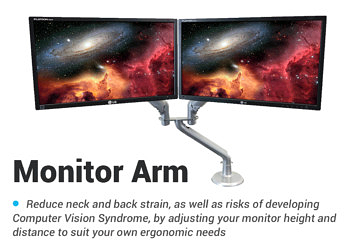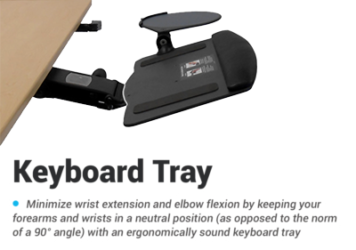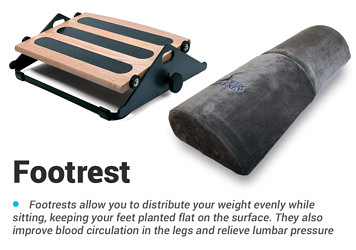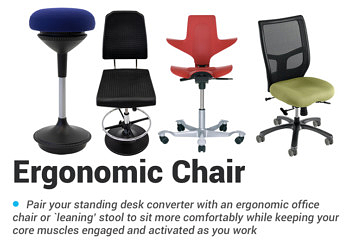UpLiftDesk E7 Electric Standing Desk Converter Review
Like most reviews sites, our editorial staff and laboratory testing expenses are partially offset by earning small commissions (at no cost to you) when you purchase something through those links. Learn More

Overview
| Review Summary |
Despite excellent weight capacity and an attractive keypad for changing height, the E7 has drawbacks. It lacks flexibility in important ergonomic spots, is difficult to set up alone, and is outclassed by similarly priced (and cheaper) electric sit-stand converters. |
|---|---|
| Best Use |
If you’re looking for a standing desk converter that can handle more than 35 lbs of equipment then electric is the way to go. The E7 handles up to 3 monitors (with some limitations on size and weight of each). |
| MSRP / List Price | $449 |
| Street Price |
Single Monitor: $449 |
| Shipping |
Arrives in 1-2 weeks |
| Warranty |
5 Years |
| Lift Type |
Jiecang 500N electric standing desk leg mounted upside-down |
| Controller |
Digital controller with segment LED readout embedded in work surface; up/down controls plus two programmable height presets |
| Colors Available |
Work surfaces come in Bamboo or Rubberwood, or powder coated in Black or White |
| Monitor Arm Mounting Options |
Dual and Triple bars are available as upgrade to default single-monitor configuration. |
| Adjustment Range |
Maximum height: 21″ from desktop, adjustable in 1″ increments |
| Weight Capacity |
Rated to 110 lbs, although max monitor weight cannot exceed 17.6 lbs each. Therefore not recommended for iMacs, all-in-one PCs or other heavy monitors. |
| Dimensions |
Desktop: 30″ W x 21.5″ D x 0.75″ H |
| Connectivity Features |
No Bluetooth |
| Product Weight |
92 lbs. |
| Shipping Weight |
Shipping dimensions Frame Box 1 – 26″ W x 34″ D x 7″ H, 40 lb |
| Typical Assembly Time |
About the same as assembling an UpLift standing desk, budget 90 minutes and have a friend handy to help you lift. |
| NEAT™ Certified by Mayo Clinic |
No |
| Competition |
Standing Desk Converter Comparison Reviews
|
| Where to buy |
Buy on Amazon |
Rating
| Ease of Assembly | |
|---|---|
| Stability | |
| Reliability | |
| Customer Experience | |
| Quality and Aesthetics | |
| Ergonomics | |
| Innovation | |
| Value | |
| Positives | The E7 boasts an impressive-sounding weight capacity of up to 110 lbs. It’s easy to adjust and features electronic presets for sitting and standing positions. With a design based on an upside-down standing desk leg, it has a height adjustment range to accommodate even the tallest of likely users. While not the winner in industrial design compared to Winston and others, the finish quality and color choices are pretty decent. |
| Negatives | There is no way to practically adjust the height of the monitor(s) relative to the keyboard height once the monitor(s) are installed, and there's no option to pan, tilt, or change focal depth of the monitor(s). Given that our spines stretch out when we stand up the monitors can only be set to the proper ergonomic height at some compromise between sitting and standing positions. This can lead to some neck craning and sore muscles after long periods of use. The keyboard tray also lacks tilt or depth adjustment and bounces a fair bit even during normal typing, which can be annoying and lead to more typos. Monitor options are fairly limited because of size and weight constraints, with maximum load on any one VESA clamp of 17.6 lbs, and max width of 28" when using the dual or triple mounting bars. Even with triple monitors less than half of the "110 lbs lift capacity" can ever actually be utilized. Could use some improvement in wire management. |
Bottom Line
Originally launched on Kickstarter in 2018 where 108 backers purchased the product, UpLift’s E7 is now in full production and a popular item among their broad selection of standing desk converters. The E7 fits squarely into a newer group of electric desk converters that manage to bring high quality to a lower price point. The top of that new group is the Eureka Electric Sit-Stand Converter ($299) and while the UpLift E7 doesn’t knock the Eureka off of its perch, it does bring a couple of unique calling cards to the discussion.

Backing up a little, does an electric standing desk converter make sense for you? Electric units sit in the middle of the road in terms of time to change height compared to other types of sit-stand converters. They’re also often noisier than other types of converters. Electric units shine with ease of movement. Those who may have a hard time leaning over may find an electric option helpful.
Electric units also excel at weight capacity. If you have heavy monitors and monitor arms, you’ll want to consider an electric unit. Those two points are really where the E7 tries to fit in. It has an easy, one-touch lifting system and massive 110-lb weight capacity—though there are some factors that limit what that capacity can actually accomplish in practice. Unfortunately, there are some fairly large ergonomic drawbacks as well.
Unboxing and Setup
The downside of the gargantuan lift capacity is apparent during unboxing and set up. The UpLift E7 weighs in at roughly a whopping 92 lbs. The weight will vary slightly, as will the work surface area, depending on which work surface and tray color you order (see Shipping Weight above). You’ll probably need a friend to help you move the two boxes into place where you’re going to assemble the unit, and you’ll definitely need some assistance lifting the bulky beast onto your desktop.
Assembling the E7 takes 60-90 minutes depending on your “IKEA assembly skills” and available tools. The directions and part labels weren’t very clear but with a little noodling anyone can figure out how to assemble the unit. One tester put it best, that it’s about the same effort as putting together a full UpLift V2 standing desk. If you’ve built one of those before than the controller style and some of the components will be familiar to you.
There are three main components to assemble: the base, the lifting column, and the work surface. If you will be using the keyboard tray, you’ll also have to attach that. In that case, take care to ensure it clears the desk edge. The keyboard tray will be lower than the desk surface when in the sitting position, so there will be an impact when lowering if the tray doesn’t clear the desk.
One important note on the size of the unit: the base requires a minimum 26″ of the depth, so if you’re planning to use it on a common 20″ to 24″-deep countertop or desktop be aware that it will hang over the front edge, potentially posing a significant stability risk.
Not a Lot of Ergonomic Flexibility
The E7’s lifting column is an upside down desk leg, the same leg used in UpLift desks that is made by Jiecang. This explains both the E7’s weight capacity and lack of ergonomic flexibility. This is an easy design approach as compared to engineering a product with a more appropriately-specified linear actuator, but since UpLiftDesk obviously buys thousands of these legs a year they have taken the shortcut of using a standard off-the-shelf leg with a 500 Newton lift capacity (like you’ll normally find used on a standing desk with a pair of legs lifting ~220 lbs).
It may at first blush appear to be a bit of overkill to use a desk leg to lift only three monitors, and in fact most of it is wasted lift capacity since the VESA monitor mounts can’t exceed 17.6 lbs each. Most laptops and any other items you can place on the tray or work surface won’t amount to more than 5 or 10 lbs, so that means even with a triple monitor setup you’ll never get to use as much as even half of the marketed 110 lbs lift capacity of the unit. The practical reason they have done this, though, is that the “side loading stresses” when employing a lifting column with all the weight on one side of it is a critical design element to consider. And in that context, 110 lbs is actually nominal. (You can learn more about this in our primer on Do Weight Ratings on Electric Desks Really Matter?)
While the monitor arms can rotate from portrait to landscape, the adjustability ends there. There is no option to pan, tilt, or change focal depth. Getting your screens at the right distance and angle from your eyes can be difficult without these options. The triple monitor arm attachment has some bend to bring the outer two monitors closer, but it’s not adjustable in the angle of the outer monitors.
You also can’t adjust the height of the monitor independently without getting behind the desk and taking out several screws. This missing feature is ergonomically problematic since our spines stretch out when we stand and we need more space between the keyboard and monitor height when we stand versus when we sit. So the best you can do is pick a monitor height setting that is in between your ideal position when sitting or when standing, and minimize the amount of neck craning you’ll be subjected to in your workday. Note that the monitor height—like the work surface height itself—only adjusts in 1″ increments, thus lacking the fine-tuning height adjustment ability of most competing converters.
Remember, one inch of forward tilt in the neck makes your (average) 12 lb head 10 lbs heavier. Two inches forward tilt means your neck muscles would be supporting 32 lbs, leading to seriously sore neck muscles and potential repetitive strain injuries (RSIs). So this inability to adjust monitor height easily when switching from sitting to standing is a big miss on the E7 design, especially for taller users. If neck strain is a common issue for you you’ll want to veer towards using a different kind of converter without a built in monitor post (e.g. a z-lift or x-lift converter) and add an articulating ergonomic monitor arm to it.
The keyboard tray descends below the desktop when lowered, giving the E7 a big plus in the ergonomics score column. However, there is no ability to change the keyboard tilt angle, an important ergonomic feature found on competitors like the iMovR ZipLift+ and others. Typing at a declined angle reduces strain on your wrists and arms that can lead to maladies like carpal tunnel syndrome, especially when standing. These are frustrating omissions because they could cause as many ergonomic problems as the desk aims to solve.

One spot where the E7 makes up some ground in flexibility is overall height adjustment. With an excellent 21”, the E7 might accommodate taller users that other desk converters can’t reach.
Designed to move
The basic design of the UpLift E7, an upturned desk leg bolted to the base, gives it massive weight capacity. It also ensures the desk will wobble. Desk legs like this are designed with glides (gaskets that separate the telescoping tubes of the lifting column and reduce friction), and there will be movement between the tubes (technically, “deflection”), especially if the manufacturing tolerances aren’t extremely precise. Jiecang is not particularly known for tight tolerances on their commodity made-in-China lifting columns, so this was not all too surprising to find.
This converter will wobble quite a bit when raised, as many users pointed out in their reviews. In watching the promotional video of the E7 on UpLiftDesk’s own website you can see how gingerly the attractive model is told to touch the keyboard and track pad when approaching the unit on camera. If you’re a ham fisted keyboard pounder the amount of shake induced on the monitor support column by your keystrokes may be amplified up to the monitors to the point of annoyance.
Because there is a gap between the work surface and the desk when fully lowered, there will also be quite a bit of shaking when typing or applying any weight to the end of the work surface—something many users complained about. A shaking keyboard can lead to using more force when pressing down on the keys, and this can lead to more strain on the wrists, and more typos.
The Motor
Here is where the UpLift E7 should stand out. The electric motor is strong and smooth. It’s also fairly quiet, which is important if you want to avoid disrupting coworkers. While mentioned already, the 110-lb capacity is worth pointing out again. It’s more than twice what the Eureka Electric Sit-Stand Converter can lift. But that capacity comes with an asterisk. The VESA monitor mounts have a weight capacity of 17.6 pounds per mount, which could be limiting. Out of the 110-lb weight capacity, less than half is available to monitors. This means, disappointingly, you will need to consider your monitor weight, despite the large weight capacity. Many of the new large-format panoramic screens can weigh two to three times more than this mount can handle.

One feature setting this unit apart from competitors is the ability to save two favorite positions. This allows you to switch between sitting and standing with a single button push. Beyond that feature, the height adjustment keypad seems to be slightly divisive. Many found its design attractive and its location convenient to reach. Others found it took up precious space. The keypad is recessed nicely into the desk surface, but some users did report pushing it accidentally during normal use. The keypad also stays lit constantly unless you unplug the desk, which could be annoying to some.
Note that the controller is mounted only 8″ from the user edge of the work surface, so if you’re not using the keyboard tray and you are using a deep keyboard like a Microsoft Natural, its back corner may sit right above the keypad. Easy fix, use the tray.
Workspace
The E7’s weight capacity, along with the VESA compatibility, should provide plenty of options when attaching a monitor. You can add either two or three monitors with the dual and triple monitor support bars. You’ll also need to consider the weight restrictions mentioned above, as well as the maximum monitor size of 28” when using these bars. The bars have sliders so you can delete the gap between smaller monitors.
At 21.5” deep, the work surface is smaller than competitors like the Eureka Electric Sit-Stand Converter (27.5”) and the Versadesk Power Pro (23.5”), which is a little disappointing when combined with the weight capacity. There’s not much room to put the extra stuff it could hold.
There are four surface styles to pick from with the UpLift E7, including bamboo and rubberwood, or UpLift’s powder-coated “Eco” surfaces in black or white. The metal parts come in either black or white. But be aware that in spite of misleading marketing, bamboo is the worst surface to select if you care about the environment. You can read more about this in our comprehensive report Bamboo Standing Desks – Separating Truth From Fiction in Environmental Claims. You can also learn about powder-coated and every other kind of desktop used in standing desk workstations in our Primer on Standing Desk Top Materials.
One minor quibble about aesthetics comes from the exposed welding where the base is attached to the motor house, which is a bit unsightly. This really should have been covered to hide something that’s normally not visible because it’s underneath the desktop. It is indeed a minor quibble though, as it’s only seen on the side view when the desk is raised.
And to make sure you’re getting the most out of your converter, check out the iMovR Tucker Pro Cable Management Kit for standing desk converters. It’s the first kit on the market designed specifically for standing desk converters.
The Takeaway
The E7 stands in an interesting middle ground. An impressive motor makes it clearly superior to slip-shod models suffering from quality problems that usually inhabit this price point for electric converters. However, with competitors like the Eureka Electric Sit-Stand Converter and even Varidesk’s Electric Sit-Stand Converter providing better products at a lower price, the E7’s lack of ergonomic flexibility and factors that limit how much of the weight capacity is usable become more glaring.






0 Comments
Leave a response >